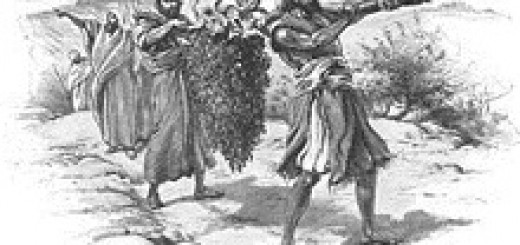By David Sterne
In this week’s episode of the Megaleh Amukot, our sixteenth century Polish sage (R’ Nosson Nata Shapira) begins with a verse from last week’s Torah portion, Balak. In this verse (Num 22:6), the Moabite sorcerer, Balak, requests from the Midianite magician, Bilam, to curse the Jewish nation who was about to enter the land of Israel. R’ Shapira points out the interesting language that Balak employs: “Go now, and curse for me this nation…” The normal way to write “Go” in Hebrew is “lech,” but here the Torah adds an extra letter hey, with the gematria (numerical value) of five, to form the word “lecha,” and R’ Shapira takes note of the anomaly. He suggests that the hey represents the “hand” of five fingers that Pinchas used to grab a spear and dispatch the two sinners, Kosby and Zimri, who were leading the Jews astray.
R’ Shapira supports his argument by pointing out the manner in which Bilam decided to curse the Jewish people. Bilam’s strategy was to distract the Jews from recognizing the unity of God as they recite the Kriat Shema. It is in this prayer that the Jews proclaim the unity of God, and it is a mitzvah (commandment from the Torah) to proclaim His unity twice a day. The initial verse contains six words and twenty-five letters, and according to R’ Shapira, Bilam sought to curse the Jews by distracting them from the first verse, which requires full focus and attention. The halacha (Jewish law) states that while reciting the Shema, which contains a total of 248 words, we must maintain focus and concentration especially during the first six words (the first verse). After that, even if we are not focused on the meaning of each and every word, we have still fulfilled the commandment. Bilam’s strategy was to find a way to distract the Jews exactly at the moment of reciting the Kriat Shema, and thereby prevent them from recognizing God’s unity.
There is a verse (Num 25:7) at the end of last week’s parsha which tells how Pinchas “took a spear in hand” (in order to kill Kosbi and Zimri). The word for “spear” – “romeach” – carries the gematria of 248. This happens to be exactly the number of words in the Kriat Shema as well as the number of positive commandments that the Jews are commanded to do from the Torah. By taking the spear of the numerical value 248, PInchas indicated that he was not deterred by Bilam’s strategy. Quite the opposite, he was determined to say the 248 words of the Kriat Shema, recognizing God’s unity and also symbolizing all 248 positive commands from the Torah. In this manner, he adopted Bilam’s strategy and “turned it on its head.” In fact, he used the spear to kill the agents of Bilam’s strategy, Zimri and Kosby. In opposition to Bilam’s curse, Pinchas took the mitzvah of Kriat Shema “in hand” (represented by the extra hey in “lecha”) to protect the Jewish people, making sure that they proclaim God’s oneness and unity every day, twice a day.
R’ Shapira further expounds, telling us that our kavana (focus of intention) during the Kriat Shema is divided into five categories, corresponding to the letters of God’s holy Name, Havaya, and to the five levels of the soul. The first and most important stage of kavana is as mentioned above, during the first verse of the Kriat Shema. In tandem with this statement of “supernal unity” are the second six words, during which we proclaim God’s unity not only in the upper spiritual realm, but also in the lower physical world. These two “unities” add up to twelve words. They are followed by the forty-two words of the first paragraph, the seventy-two words of the second paragraph (up to vesamtem), and then the remaining fifty words of the second paragraph and finally by the 69 words of the third paragraph (tzitzit). When we add the last three words (Hashem Elokeichem emet) of the final paragraph, which we repeat a second time, they add up to 248 words, which is the gematria of the “romeach,” or “spear” that Pinchas took in hand. In other words, according to this interpretation by R’ Shapira, the Jewish “spear” is the Kriat Shema that we say twice a day, proclaiming the unity of God and thus defending the Jewish people from our enemies.
Further developing his thesis, R’ Shapira quotes from Psalms (106:30), which says, “And Pinchas stood and prayed and arrested the plague….” This verse also contains five words, each word containing five letters, corresponding to the twenty-five letters of the Kriat Shema. The recurring theme of five, according to R’ Shapira, corresponds to two different motifs. One is the five partzufim (structures of sephirot that occur naturally in the creation of the world). There are five such structures, from keter (the “crown” or infinite will of God) down to chochma (first of the ten sephirot), bina (second sephira), za (the six “emotional” sephirot that relate to the “other”) and finally malchut (the tenth and final sephira, that has no intrinsic divinity of its own and only receives from the sephirot above it).
And the second motif of “five” is the five levels of the soul. When Pinchas performed his act of zealotry with the spear, he achieved the highest level of soul revelation, called yechida. This is the essence of the soul, and it is also the level that Moshe achieved when he ascended Mt. Sinai to receive the Torah. The other four levels of the soul are the chaya (corresponding to the will or chochma), the neshama (corresponding to intellect, or bina), ruach (corresponding to the emotions, or z’a) and nefesh (malchut). Thus, Rabbi Shapira demonstrates that the extra letter hey that occurred when Balak asked Bilam to “go and curse the Jewish people,” is certainly not extraneous – it alludes to some very high spiritual levels that Pinchas achieved with his singular act, which saved the Jewish people and protected us for generations. This is also why Pinchas was rewarded by becoming a priest. The job of the priests is to foster peace, even while maintaining proper divisions and categories, and that is what Pinchas excelled at. In addition, the message for all of us is to be careful and scrupulous about fulfilling all of the 613 commandments, and especially the Kriat Shema, which corresponds to all of the positive mitzvot.
Rabbi David Sterne is a prolific author on chassidic thought and has translated many of its seminal works. He resides in Israel and is the director of Jerusalem Connection. To read more of his work and to purchase his books visit http://www.jewishspiritualbook






















